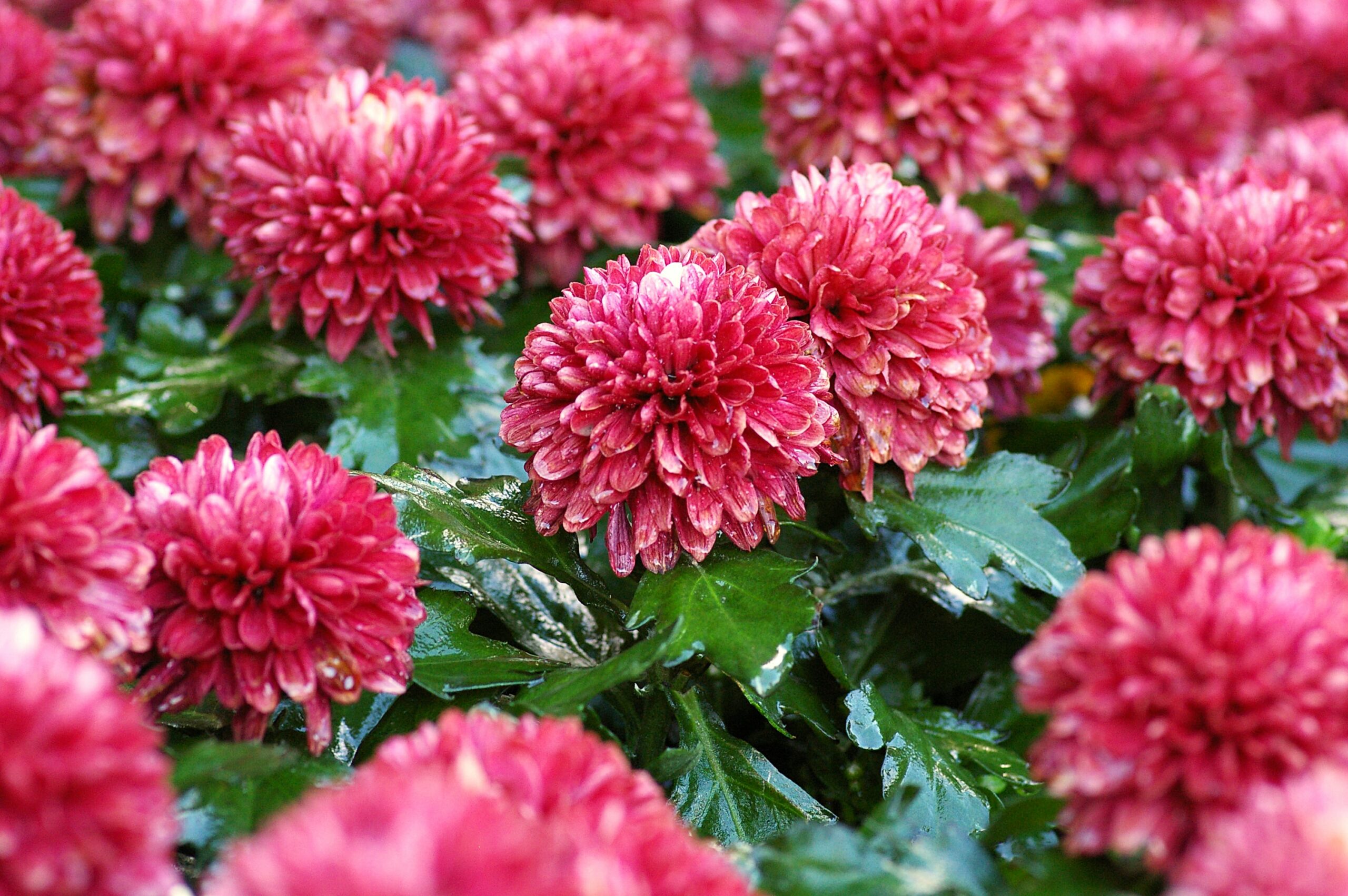The Chrysanthemum, often referred to as the “Mum”, is a flower that has been cultivated for centuries. It’s vibrant colors and distinct shape make it a popular choice among gardeners and flower enthusiast alike. But the Mum isn’t just beautiful – it’s also easy to grow, maintain and care for in your own home! In this article, we will explore how to plant, grow and care for Mums so that you can enjoy their beauty all season long.
Have you ever wanted to add a touch of elegance to your yard or garden? No need to look any further than the Chrysanthemum! With its vibrant colors and unique shapes, these flowers are sure to turn heads and bring life wherever they are planted. Whether you’re an experienced gardener or looking for an easy-to-care-for addition to your outdoor space, Mums are the perfect option. While they may seem intimidating at first, we’ll show you how simple it is to get them started in no time.
With our simple guide on planting, growing and caring for Mums, you’ll be amazed at how quickly these blooms will come alive in your space. So grab your gardening tools and let’s get started!
Choosing The Best Type Of Mums For Your Garden
When it comes to choosing the best type of mums for your garden, there are many factors to consider. Firstly, you need to determine the purpose of the mums: Are they for ornamental use or for cut flowers? Secondly, consider the climate and hardiness zone in which you live. Lastly, choose a mum variety that is suitable for your garden’s soil and light conditions.
Paralleling these criteria is selecting a mum variety with optimal bloom time. For example, if you want your mums to flower in the fall season, opt for autumn-flowering varieties like daisy-type mums and spider mums. On the other hand, if you prefer spring blooms, choose from early-, mid-, or late-spring flowering cultivars like Shasta daisies or Korean chrysanthemums.
Once you decide on a type of mum that best suits your needs and growing conditions, it’s time to decide where to plant them.
Deciding Where To Plant Mums
The journey to creating a beautiful garden filled with mums starts with deciding where they should be planted. Choosing the right location is essential for their success. As such, it is important to consider placement carefully. To do this, rhythmic rhythm of the words roll off our tongues as we consider what environment will encourage the best growth.
When choosing a spot for planting mums, it’s essential to look for areas that receive six or more hours of direct sun each day. Additionally, you’ll want to pick an area with well-draining soil and shelter from strong winds; otherwise, your plants may struggle or fail to thrive. Consider how much space you can provide too; mums should have enough room for the roots to grow and spread out without becoming crowded so that they can reach full size and bloom properly.
Before planting your mums, it’s necessary to prepare the soil properly by adding compost or other organic materials like manure or peat moss to improve drainage and ensure nutrients are present in the soil. Once this is done, you’re ready for planting! With careful consideration of these factors, you’ll be able to create a stunning garden filled with vibrant blooming mums in no time.
Preparing The Soil For Planting Mums
Coincidentally, the next step in growing mums is preparing the soil. This is an essential part of the process and it’s important to ensure that the soil is healthy and provides the best environment for your mums to grow. Here are 5 things to keep in mind when preparing your soil:
- Start by testing your soil pH levels – you want a pH level of 6-7 for optimal growth
- Incorporate organic materials like compost or aged manure into your soil
- Use fertilizers with nutrients specifically designed for mums
- Loosen up compacted soils with a garden fork or tiller
- Make sure your soil is well draining, so water can move freely through it
When you have completed these steps, you should have a healthy, nutrient rich environment ready for planting mums in your garden. It’s important to note that these same principles apply when planting any type of flower or plant in any type of environment – making sure that your plants have access to the right kind of soil can be the difference between success and failure. With these tips in mind and some patience, you can easily create an inviting space filled with beautiful flowers! As we move on from this section, let’s talk about how to actually plant mums in the garden …
Planting Mums In The Garden
Planting mums in the garden is a great way to add a burst of colorful blooms to any outdoor space. To get started, let’s talk about prepping the soil for planting. After all, it doesn’t matter how beautiful the flowers are if they don’t have a place to call home!
We’ll begin by making sure that your garden bed has proper drainage and then adding plenty of organic material such as compost or aged manure. This will ensure that your mums get enough nutrients throughout their growing period. You can then dig a hole in the prepared soil, deep enough to accommodate the roots of the mum plant. When selecting an area for planting, look for spots with full sun exposure where they will be able to thrive without being overcrowded by other plants or shrubs.
Once the soil has been readied and you’ve selected the perfect spot, it’s time to actually get down to business and plant your mums! Place each one carefully into its individual hole and gently pat down around them before covering with soil. Water thoroughly so that the mums are well-hydrated, and be sure to water them every few days going forward as needed during dry spells. With these steps you’re well on your way to growing and caring for beautiful mums!
Planting Mums In Containers
Planting mums in containers is like an art form – a beautiful way to add some vibrancy to your home. It’s not as difficult as it looks, and with the right guidance, you can have them flourishing in no time.
First off, make sure you’ve got the right size container for your mums. If they’re too big or too small they won’t thrive and could become root-bound. Pick out a pot with drainage holes to help prevent overwatering and drowning your plants. Then fill it up with soil and fertilizer – this will give them the nutrients they need to grow.
Once you’ve got the right environment for your mums, it’s time to get planting! Planting them in a container can be tricky but follow these steps: remove the plant from its pot, loosen the roots so that they’re not all bunched together, then place them into the new pot at an appropriate depth. Gently press down on the soil around the plant and water thoroughly.
With proper care and attention, your mums should be thriving in their new home in no time. Watering and mulching are key to keeping them healthy – we’ll take a look at how to do that next.
Watering And Mulching Mums
To keep the mums growing strong and healthy, the next step is to water and mulch them. It’s essential to get this right in order to reap the rewards of a beautiful garden. Like many other plants, mums need an adequate amount of water in order to thrive. To ensure they are receiving enough moisture, it is best to check soil for moisture daily. If the soil is dry one inch below the surface, you should give them a good watering – as they say, there’s no time like the present!
Mulching your mums can also benefit their health. This helps retain moisture and keeps down weeds from competing with your plant for nutrients. As an added bonus, it gives your garden beds a neat and tidy look! Spread a few inches of mulch over the soil around each mum, taking care not to pile too high near the stem or foliage.
Caring for mums doesn’t stop there – fertilizing can help promote even more gorgeous blooms come fall. With these tips in mind, you’ll be on your way to having vibrant chrysanthemums that will last through autumn and beyond.
Fertilizing Mums
“A stitch in time saves nine” – and this is certainly the case when it comes to fertilizing mums. To ensure that your mums remain healthy, taking the time to fertilize them regularly will pay off in the long run.
Mums can benefit from a balanced fertilizer with an N-P-K ratio of 10-10-10 or 12-6-6 every few weeks when they are actively growing. If you prefer a liquid feed, diluted fish emulsion or seaweed extract are both great options. It’s important to follow the directions on any fertilizer you use as overfertilizing can damage your plants.
You should also consider adding some organic material like compost or aged manure around the base of each plant to provide extra nourishment. This helps create a healthier environment for the roots which encourages better growth and blooms.
By taking these steps, you’ll be well on your way to successfully pruning and deadheading mums for maximum health and beauty!
Pruning And Deadheading Mums
Pruning and deadheading mums may seem like a daunting task, but it’s actually quite simple. Take my friend, for example. She recently planted a perennial chrysanthemum in her garden, and she’s been pruning and deadheading it throughout the growing season. By doing this, she ensures that the plant stays healthy and blooms each year.
Pruning mums involves cutting away any old or damaged stems before new flowers emerge. This helps to promote growth of new stems that can produce more flowers. Deadheading is simply removing spent flowers when they start to fade or die off. This prevents the plant from wasting energy on producing seeds and encourages more flowering instead. It’s important to note that both pruning and deadheading should be done gently to avoid damaging the stems or leaves of the mum plants.
The benefits of pruning and deadheading mums are plentiful. Doing so will not only help keep them looking tidy, but also encourage more robust blooming over time. Plus, if you’re diligent with your pruning and deadheading efforts, you’ll be rewarded with bigger, brighter blooms! Now that we’ve discussed how to prune and deadhead mums effectively, let’s move on to discussing how to control pests and diseases in these beautiful plants.
Controlling Pests And Diseases In Mums
Controlling pests and diseases in mums is like a game of chess; it requires careful strategy and vigilance. The first step is to scout for any signs of trouble. Watch out for wilting or discoloration, as well as any insects crawling around the stems or leaves. If you find any, take action right away using organic methods like neem oil, insecticidal soap, or horticultural oil. These can help control infestations without harming beneficial insects in your garden.
Next, practice preventative measures such as soil maintenance and proper watering habits to reduce the risk of infection. Maintain healthy soil with compost or manure to feed plants and promote strong root systems that are better able to resist pests and diseases. And when watering mums, try not to wet foliage to minimize fungal growth on the leaves.
Finally, keep an eye out for common pests and diseases specific to mums like powdery mildew or aphids. Research which treatments are best for these particular problems so that you’re prepared if they show up in your garden. Taking proactive steps now will ensure your mums stay healthy throughout their life cycle—and ready for overwintering for the next season!
Overwintering Mums For The Next Season
Mums are delightful plants that offer a wide variety of colors and blooms, making them incredibly popular for gardening enthusiasts. Unfortunately, many gardeners don’t realize that overwintering mums is key to ensuring they will return in the next season. Overwintering mums is essential – it’s like giving your plants the gift of life!
First and foremost, when overwintering mums, it’s important to protect them from potential frost and cold temperatures. This can be achieved by covering the plants with mulch or frost cloths, as well as trimming back dead foliage and cutting away any diseased branches. Make sure to water them throughout winter so their roots remain moist; this will help their survival and ensure they come back bigger and brighter in springtime.
The final step in overwintering is maintaining a consistent soil temperature. While keeping the soil moist is crucial, you also want to make sure it doesn’t get too cold or warm. Adding insulation such as straw or pine needles can help keep your mums safe throughout the winter months. With these tips in mind, you’ll have no trouble keeping your beloved mums alive until next season rolls around! With proper care and attention given to overwintering mums, you’ll soon be rewarded with beautiful blooms that look just as fine as they did before!
Growing Mums From Cuttings
The best things in life take effort, and growing mums from cuttings is no different. With a bit of care and attention, you can grow beautiful mums in your garden or balcony. Here’s how to get started!
To begin, you’ll need to collect some mum cuttings – these should be about 4-8 inches long with five or more leaves attached. Once you’ve got the cuttings, dip them in rooting hormone before planting them in the soil. Make sure they’re planted at least 3 inches deep and spaced at least 8 inches apart. Water regularly but avoid overwatering as this can cause root rot.
Finally, give your cuttings plenty of sunlight (at least 6 hours per day). To encourage strong growth, fertilize every two weeks using a low nitrogen fertilizer throughout the summer months. With regular care and maintenance, you should have healthy blooming mums to enjoy for years to come!
Growing Mums From Seeds
Growing mums from seeds is a great way to increase the number of plants in your garden. There are several steps you’ll need to take before planting the seeds, such as soaking them overnight and pre-germinating them. Once you’ve done this, you can sow the seeds directly into the soil or into small pots. Keep the soil moist during germination, and make sure the temperature is around 70°F for optimal growth.
When it comes to light and water requirements, mums grown from seed need around 4 hours of sunlight each day and plenty of water – about 1 inch per week. You may want to fertilize your plants regularly with a balanced fertilizer to help ensure they grow strong and healthy.
It’s important to remember that mums grown from seed will usually not bloom until their second year – so don’t be discouraged if they don’t produce flowers right away! With proper care and patience, you should have beautiful blooms in no time. Moving forward with our journey in caring for mums, let’s look at how to grow them from divisions.
Growing Mums From Divisions
What a coincidence – just when you were looking for information on how to plant, grow and care for mums, we have arrived at the perfect place! Step 13 is all about growing mums from divisions.
Division is an easy way to propagate your mums or get new ones. You will need to dig up the entire clump of plants and separate it into pieces with a sharp spade or knife. Each division should have four to five strong shoots and some roots attached. Replant the divisions in well-draining soil, spaced apart in their own individual holes. Water them thoroughly and make sure they are in an area that gets plenty of sunlight. This method can also be used if you want to divide overly large mums into two or more plants.
Once the divisions are planted, maintain them as you would any other mum – water regularly, fertilize when necessary and keep an eye out for pests or disease. With proper care and enough sunlight, your mums will quickly establish themselves in their new home! Now let’s move on to using mums in floral arrangements…
Using Mums In Floral Arrangements
Beautifying the outdoors with blooming mums is a wonderful way to bring the garden alive. Using these vibrant flowers in floral arrangements can create gorgeous displays, whether indoors or out. Exploring all of the potential options when it comes to decorating with mums will provide endless possibilities for transforming any space.
The art of floral design allows for an abundance of creativity and innovation. Taking the time to explore different techniques for arranging mums within a bouquet or centerpiece can be incredibly rewarding. Often times, contrasting colors or sizes can create interesting visual effects that will draw viewers’ eyes to the arrangement. Additionally, learning about how different elements like foliage, ribbon, and other types of flowers can accentuate mums will help ensure beautiful results each time.
Mums are special flowers that add an element of cheerfulness wherever they are used. Incorporating them into designs helps emphasize their ability to bring joy and beauty into any setting. With some creative thought and effort, anyone can make use of these versatile blooms in ways that will enhance their surroundings and evoke smiles from all who see them.
Tips For Growing Healthy Mums
Like a ray of sunshine in the garden, mums (chrysanthemums) can bring an abundance of color and cheer to any outdoor area. To ensure these beautiful blooms are flourishing and healthy, here are some helpful tips for growing mums.
From sowing seeds with care to providing proper watering habits, cultivating mums is a labor of love. As the saying goes, “You reap what you sow.” For best results, scatter the seeds in a sunny area within your garden and cover them with a thin layer of soil. When it comes to watering, soak the soil every few days if there hasn’t been any rainfall.
To keep your beloved mums in peak condition, apply a moderate amount of fertilizer every few weeks and be sure to deadhead spent flowers – that way you’ll be rewarded with more vibrant blooms! By following these simple steps, you can enjoy these eye-catching plants throughout the season.
Frequently Asked Questions
How Often Should I Water My Mums?
To have a beautiful garden of mums, you need to know the right way to care for them. Caring for mums often involves a delicate balance of providing enough water so they don’t dry out, but not too much that they become water-logged and soggy. Like Goldilocks, we want to get it just right!
Watering your mums is one of the most important things you can do for them. To keep your mums looking their best, it’s essential to give them a good drink every few days. This regular watering encourages blooms and lush foliage for as long as possible. But how often should you be watering your mums?
The answer depends on several factors like the soil type, season and climate where you live, how much sun exposure your plants are getting, and how large the pot or bed is that your mums are planted in. As a general rule though, a deep soaking once or twice a week should be sufficient during summer months – when the weather is warmer – whereas once every two weeks will suffice during cooler months in autumn. If you’re ever unsure whether to water your mums or not, remember this: err on the side of caution by going with less rather than more!
What Is The Best Time Of Year To Plant Mums?
The chrysanthemum, with its vast array of colours and styles, is a symbol of joy and optimism. Planting mums in the garden at the right time of year can ensure that they thrive and bloom for years to come. What is the best time of year to plant mums?
The ideal time to start planting mums is in late spring or early summer. At this time, the soil has warmed up enough for them to take root easily, but not so much that it dries out quickly. To add extra protection from sudden temperature changes, mulch around the plants can help keep the roots cool. Additionally, it’s important to give them plenty of sun during their first season by choosing a spot that gets six hours or more per day.
It’s also important to remember that mums prefer cooler temperatures in general. Therefore, if you live in an area with hot summers, consider planting them on the north or east side of your house so they won’t be exposed to too much direct sunlight during those months. With proper preparation and care, your mums will reward you with vibrant blooms throughout autumn and into winter!
How Can I Tell When My Mums Need To Be Fertilized?
It’s important to get the timing of fertilizing mums right – but how can you tell when it’s time? According to the National Chrysanthemum Society, most mums need to be fertilized every four to six weeks during their growing season. This will help keep them lush and blooming for as long as possible.
As with any plant, there are a few signs that mums may need some extra nutrition. If the leaves start yellowing or if the blooms appear sparse and weak, then it’s likely time for a fertilizer boost. Other signs include wilting or drooping of stems and reduced growth rate.
To make sure your mums stay healthy and happy, regular fertilization is key. With careful observation and timely feeding, you can ensure your potted mums not only survive but thrive throughout the growing season!
Do Mums Need To Be Pruned Every Year?
Caring for mums can be a tricky task, but with the right know-how and attention, you’ll have beautiful blooms that last all season. Pruning is an integral part of any garden maintenance routine to ensure your mums are growing strong and healthy. But do mums need to be pruned every year? Let’s find out.
Like a butterfly emerging from its cocoon, regular pruning helps mums to blossom into their fullest potential. This annual ritual involves cutting away dead or damaged branches and shoots, as well as pinching off spent flowers. Not only does this encourage bushier growth and larger blooms, it also helps increase air circulation in and around the plant which keeps diseases at bay.
In short, yes! Pruning your mums every year is essential for keeping them healthy and looking their best. Whether you’re a novice gardener or a seasoned professional, taking the time to properly care for your mums will give you stunning results that will last throughout the season.
How Can I Tell If My Mums Are Affected By Pests Or Diseases?
It’s natural to want vibrant, gorgeous mums in your garden. However, pests and diseases can be detrimental to your mum’s health. Knowing how to tell if your mums are affected is key to keeping them healthy. Let’s explore how you can identify if something’s wrong with your chrysanthemums.
The first sign of trouble could be discoloration in the leaves or wilting stems and petals. Take a closer look at the leaves for any small holes or black spots – these could indicate an infestation of some kind. Plus, keep an eye out for any webbing or fuzzy masses that appear on the leaves or stems of the plants, as these can also be signs of pests.
Diseases such as powdery mildew and rust may also affect your mums. Mildew appears as a white powdery substance on the plant’s foliage while rust appears as orange spots on the undersides of leaves. If you notice either of these, prune away infected parts and treat with fungicides accordingly – this should help stop further spread of disease.
These simple steps should help you ensure that your mums stay beautiful and flourishing all season long. With regular care and attention, you won’t have to worry about any unwelcome guests taking over—and you can enjoy watching your mums grow in all their glory!
Conclusion
Mums are a beautiful addition to any garden and with the right care and attention, they can bring much joy. With proper watering, planting at the right time of year, fertilizing, and pruning as needed, your mums will thrive. Keeping an eye out for pests or diseases is also important in ensuring that your mums stay healthy and look their best.
Taking the time to learn how to properly care for your mums can be very rewarding. Not only do you get the pleasure of seeing them grow and bloom in all their glory each year, but you also have the satisfaction of knowing that you kept them healthy and happy.
So why not give it a try? Investing in a little extra effort now pays off with a beautiful garden full of vibrant mums for years to come. Who knows – maybe you’ll even become an expert on mum gardening!





























